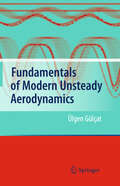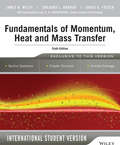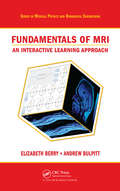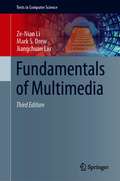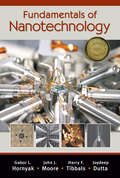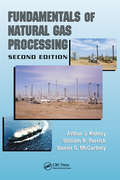- Table View
- List View
Fundamentals of Microwave Photonics (Wiley Series in Microwave and Optical Engineering)
by V. J. Urick Keith J. Williams Jason D. McKinneyA comprehensive resource to designing and constructing analog photonic links capable of high RF performance Fundamentals of Microwave Photonics provides a comprehensive description of analog optical links from basic principles to applications. The book is organized into four parts. The first begins with a historical perspective of microwave photonics, listing the advantages of fiber optic links and delineating analog vs. digital links. The second section covers basic principles associated with microwave photonics in both the RF and optical domains. The third focuses on analog modulation formats—starting with a concept, deriving the RF performance metrics from basic physical models, and then analyzing issues specific to each format. The final part examines applications of microwave photonics, including analog receive-mode systems, high-power photodiodes applications, radio astronomy, and arbitrary waveform generation. Covers fundamental concepts including basic treatments of noise, sources of distortion and propagation effects Provides design equations in easy-to-use forms as quick reference Examines analog photonic link architectures along with their application to RF systems A thorough treatment of microwave photonics, Fundamentals of Microwave Photonics will be an essential resource in the laboratory, field, or during design meetings. The authors have more than 55 years of combined professional experience in microwave photonics and have published more than 250 associated works.
Fundamentals of Modern Digital Systems
by B. R. Bannister Donald Gill WhiteheadAn ELBS/LPBB edition is available.
Fundamentals of Modern Electric Circuit Analysis and Filter Synthesis: A Transfer Function Approach
by Afshin IzadianThis textbook explains the fundamentals of electric circuits and uses the transfer function as a tool to analyze circuits, systems, and filters. The author avoids the Fourier transform and three phase circuits, since these topics are often not taught in circuits courses. General transfer functions for low pass, high pass, band pass and band reject filters are demonstrated, with first order and higher order filters explained in plain language. The author’s presentation is designed to be accessible to a broad audience, with the concepts of circuit analysis explained in basic language, reinforced by numerous, solved examples.
Fundamentals of Modern Electric Circuit Analysis and Filter Synthesis: A Transfer Function Approach
by Afshin IzadianThis textbook explains the fundamentals of electric circuits and uses the transfer function as a tool to analyze circuits, systems, and filters. The author avoids the Fourier transform, since this topic is often not taught in circuits courses. General transfer functions for low pass, high pass, band pass and band reject filters are demonstrated, with first order and higher order filters explained in plain language. The author’s presentation is designed to be accessible to a broad audience, with the concepts of circuit analysis explained in basic language, reinforced by numerous, solved examples.
Fundamentals of Modern Manufacturing: Materials, Processes, and Systems
by Mikell P. GrooverFundamentals of Modern Manufacturing: Materials, Processes, and Systems, 6th Edition, is designed for a first course or two-course sequence in Manufacturing at the junior level in Mechanical, Industrial, and Manufacturing Engineering curricula. As in preceding editions, the author's objective is to provide a treatment of manufacturing that is modern and quantitative. The book's modern approach is based on balanced coverage of the basic engineering materials, the inclusion of recently developed manufacturing processes and comprehensive coverage of electronics manufacturing technologies. The quantitative focus of the text is displayed in its emphasis on manufacturing science and its greater use of mathematical models and quantitative end-of-chapter problems.
Fundamentals of Modern Unsteady Aerodynamics
by Ülgen GülçatIn this book, the author introduces the concept of unsteady aerodynamics and its underlying principles. He provides the readers with a comprehensive review of the fundamental physics of free and forced unsteadiness, the terminology and basic equations of aerodynamics ranging from incompressible flow to hypersonics. The book also covers modern topics related to the developments made in recent years, especially in relation to wing flapping for propulsion. The book is written for graduate and senior year undergraduate students in aerodynamics and also serves as a reference for experienced researchers. Each chapter includes ample examples, questions, problems and relevant references. The treatment of these modern topics has been completely revised end expanded for the new edition. It now includes new numerical examples, a section on the ground effect, and state-space representation.
Fundamentals of Modern Unsteady Aerodynamics
by Ülgen GülçatThis book introduces the concept of unsteady aerodynamics and its underlying principles. The author provides the readers with a comprehensive review of the fundamental physics of free and forced unsteadiness, the terminology and basic equations of aerodynamics ranging from incompressible flow to hypersonics. The book also covers modern topics related to the developments made in recent years, especially in relation to wing flapping for propulsion. The book is written for graduate and senior year undergraduate students in aerodynamics and also serves as a reference for experienced researchers. Each chapter includes ample examples, questions, problems and relevant references.This 3rd edition includes a new chapter about unsteady applications related to the thrust optimization, aerodynamic stability and trim because there has been much progress in unsteady applications of the flapping wing technology. In addition, further material is presented in Appendix for evaluating the stability derivatives so that no derivation of equations is left incomplete but not overdone in the text.
Fundamentals of Modern Unsteady Aerodynamics
by Ülgen GülçatIn this textbook, the author introduces the concept of unsteady aerodynamics and its underlying principles. He provides the readers with a full review of fundamental physics of the free and the forced unsteadines, the terminology and basic equations of aerodynamics ranging from incompressible flow to hypersonics. The book also covers the modern topics concerning the developments made during the last years, especially in relation to wing flappings for propulsion. The book is written for graduate and senior year undergraduate students in Aerodynamics, and it serves as a reference for experienced researchers. Each chapter includes ample examples, questions, problems and relevant references.
Fundamentals of Momentum, Heat and Mass Transfer, 6th Edition International Student Version
by James Welty Gregory L. Rorrer David G. FosterFundamentals of Momentum, Heat, and Mass Transfer, now in its sixth edition, continues to provide a unified treatment of momentum transfer (fluid mechanics), heat transfer, and mass transfer. This new edition has been updated to include more coverage of modern topics and new applications, such as macro- and micro-scale chemical reactors. Additionally, the sixth edition focuses on an explicit problem-solving methodology that is thoroughly and consistently implemented throughout the text. It is designed for undergraduates taking transport phenomena or transfer and rate process courses.
Fundamentals of MRI: An Interactive Learning Approach (Series in Medical Physics and Biomedical Engineering)
by Elizabeth BerryFundamentals of MRI: An Interactive Learning Approach explores the physical principles that underpin the technique of magnetic resonance imaging (MRI).After covering background mathematics, physics, and digital imaging, the book presents fundamental physical principles, including magnetization and rotating reference frame. It describes how relaxati
Fundamentals of Multibody Dynamics: Theory and Applications
by Farid AmiroucheThis textbook – a result of the author’s many years of research and teaching – brings together diverse concepts of the versatile tool of multibody dynamics, combining the efforts of many researchers in the field of mechanics.
Fundamentals of Multimedia (Texts in Computer Science)
by Ze-Nian Li Mark S. Drew Jiangchuan LiuPREVIOUS EDITIONThis textbook introduces the “Fundamentals of Multimedia”, addressing real issues commonly faced in the workplace. The essential concepts are explained in a practical way to enable students to apply their existing skills to address problems in multimedia. Fully revised and updated, this new edition now includes coverage of such topics as 3D TV, social networks, high-efficiency video compression and conferencing, wireless and mobile networks, and their attendant technologies. Features: presents an overview of the key concepts in multimedia, including color science; reviews lossless and lossy compression methods for image, video and audio data; examines the demands placed by multimedia communications on wired and wireless networks; discusses the impact of social media and cloud computing on information sharing and on multimedia content search and retrieval; includes study exercises at the end of each chapter; provides supplementary resources for both students and instructors at an associated website.
Fundamentals of Multiphase Heat Transfer and Flow
by Amir Faghri Yuwen ZhangThis textbook presents a modern treatment of fundamentals of heat and mass transfer in the context of all types of multiphase flows with possibility of phase-changes among solid, liquid and vapor. It serves equally as a textbook for undergraduate senior and graduate students in a wide variety of engineering disciplines including mechanical engineering, chemical engineering, material science and engineering, nuclear engineering, biomedical engineering, and environmental engineering. Multiphase Heat Transfer and Flow can also be used to teach contemporary and novel applications of heat and mass transfer. Concepts are reinforced with numerous examples and end-of-chapter problems. A solutions manual and PowerPoint presentation are available to instructors. While the book is designed for students, it is also very useful for practicing engineers working in technical areas related to both macro- and micro-scale systems that emphasize multiphase, multicomponent, and non-conventional geometries with coupled heat and mass transfer and phase change, with the possibility of full numerical simulation.
Fundamentals of Multisite Radar Systems: Multistatic Radars and Multistatic Radar Systems
by V S ChernyakThis is an original and comprehensive monograph on the increasingly important field of Multistatic Radar Systems. The material covered includes target detection, coordinate and trajectory parameter estimation, optimum and suboptimum detectors and external interferences. The practical problems faced by those working with radar systems are considered - most algorithms are presented in a form allowing direct use in engineering practice, and many of the results can be immediately applied to information systems containing different types of sensors, not only radars. This book is the revised international edition of Chernyak's renowned Russian textbook.
Fundamentals of Multisite Radar Systems: Multistatic Radars and Multistatic Radar Systems
by V S ChernyakThis is an original and comprehensive monograph on the increasingly important field of Multistatic Radar Systems. The material covered includes target detection, coordinate and trajectory parameter estimation, optimum and suboptimum detectors and external interferences. The practical problems faced by those working with radar systems are considered - most algorithms are presented in a form allowing direct use in engineering practice, and many of the results can be immediately applied to information systems containing different types of sensors, not only radars. This book is the revised international edition of Chernyak's renowned Russian textbook.
Fundamentals of Music Processing: Audio, Analysis, Algorithms, Applications
by Meinard MüllerThis textbook provides both profound technological knowledge and a comprehensive treatment of essential topics in music processing and music information retrieval. Including numerous examples, figures, and exercises, this book is suited for students, lecturers, and researchers working in audio engineering, computer science, multimedia, and musicology.The book consists of eight chapters. The first two cover foundations of music representations and the Fourier transform—concepts that are then used throughout the book. In the subsequent chapters, concrete music processing tasks serve as a starting point. Each of these chapters is organized in a similar fashion and starts with a general description of the music processing scenario at hand before integrating it into a wider context. It then discusses—in a mathematically rigorous way—important techniques and algorithms that are generally applicable to a wide range of analysis, classification, and retrieval problems. At the same time, the techniques are directly applied to a specific music processing task. By mixing theory and practice, the book’s goal is to offer detailed technological insights as well as a deep understanding of music processing applications. Each chapter ends with a section that includes links to the research literature, suggestions for further reading, a list of references, and exercises. The chapters are organized in a modular fashion, thus offering lecturers and readers many ways to choose, rearrange or supplement the material. Accordingly, selected chapters or individual sections can easily be integrated into courses on general multimedia, information science, signal processing, music informatics, or the digital humanities.
Fundamentals of Music Processing: Using Python and Jupyter Notebooks
by Meinard MüllerThe textbook provides both profound technological knowledge and a comprehensive treatment of essential topics in music processing and music information retrieval (MIR). Including numerous examples, figures, and exercises, this book is suited for students, lecturers, and researchers working in audio engineering, signal processing, computer science, digital humanities, and musicology.The book consists of eight chapters. The first two cover foundations of music representations and the Fourier transform—concepts used throughout the book. Each of the subsequent chapters starts with a general description of a concrete music processing task and then discusses—in a mathematically rigorous way—essential techniques and algorithms applicable to a wide range of analysis, classification, and retrieval problems. By mixing theory and practice, the book’s goal is to offer detailed technological insights and a deep understanding of music processing applications.As a substantial extension, the textbook’s second edition introduces the FMP (fundamentals of music processing) notebooks, which provide additional audio-visual material and Python code examples that implement all computational approaches step by step. Using Jupyter notebooks and open-source web applications, the FMP notebooks yield an interactive framework that allows students to experiment with their music examples, explore the effect of parameter settings, and understand the computed results by suitable visualizations and sonifications. The FMP notebooks are available from the author’s institutional web page at the International Audio Laboratories Erlangen.
Fundamentals of Nano-Textile Science
by Prashansa Sharma Devsuni Singh Vivek DaveFundamentals of Nano-Textile Science provides a detailed overview of advanced nano-textiles methods, techniques, and treatments along with explanations of a wide range of applications. This book places emphasis on nanotechnology-based textile enhancements that provide high durability, better affinity, and more functionality in textile material and that overcomes the limitation of conventional processes in the textile industry. The first section of the book deals with the production method of nano-textile fibers. It elaborates how nano-techniques are used for producing textile fiber and discusses various pretreatment processes of textile materials using such methods as nano-scouring, nanobiophotoscouring, nano-bleaching, nano-softening, and nano-surface activation. The second section discusses the wide range of nanofinishing applications to make textile materials antimicrobial, flame retardant, UV-protected, etc. It also discusses different techniques and treatments applied on the surface of the finished product using plasma technology or layer-by-layer deposition techniques. This section also covers nano-based textile applications such as for sports clothing, military textiles, high-performance clothing, or smart wearable high-tech nano-textiles. In the last section, the book concludes with an overview of nanotechnological advancements being used for the management of textile effluents and for removing dyes from wastewater in textile processing, focusing on the health and safety perspective of nano-textiles. The book is written by highly experienced authors in this area and provides an immensely valuable resource for scientific researchers, academics, professionals, engineers, technologists and innovators working on designing and manufacturing textile materials. The volume will be an important resource for those who are looking for innovative production technologies or the latest nanotechnology developments in the design and manufacturing of nano-textile materials. Key features: Provides a detailed theoretical overview of nano-textiles along with novel advanced techniques, methods, treatments for enhanced properties and applications of textiles. Covers relevant techniques applied on the surface of the finished textile product using plasma technology or layer-by-layer deposition techniques Introduces various nanofinishes and applications including for sports clothing, military textiles, high performance clothing or smart wearable high-tech textiles Describes wearable smart nano-textile parameters, types of materials used, applications, and future innovations for prevention of hazards and pandemic diseases Explores innovative methods and treatments for management or removal of textile waste
Fundamentals of Nanomechanical Resonators
by Silvan Schmid Luis Guillermo Villanueva Michael Lee RoukesThis authoritative book introduces and summarizes the latest models and skills required to design and fabricate nanomechanical resonators with a focus on nanomechanical sensing. It also establishes the theoretical foundation for courses on micro and nanomechanics. This book takes an applied approach to nanomechanics, providing a complete set of mechanical models, including strings and membrane resonators. Also discussed are quality factors, noise issues, transduction techniques, nanomechanical sensing, fabrication techniques, and applications for all common nanomechanical resonator types. It is an ideal book for students and researchers working with micro and nanomechanical resonators.
Fundamentals of Nanomechanical Resonators
by Silvan Schmid Luis Guillermo Villanueva Michael Lee RoukesNow in an updated second edition, this classroom-tested textbook introduces and summarizes the latest models and skills required to design and optimize nanomechanical resonators, taking a top-down approach that uses macroscopic formulas to model the devices. The authors cover the electrical and mechanical aspects of nanoelectromechanical system (NEMS) devices in six expanded and revised chapters on lumped-element model resonators, continuum mechanical resonators, damping, transduction, responsivity, and measurements and noise.The applied approach found in this book is appropriate for engineering students and researchers working with micro and nanomechanical resonators.
Fundamentals of Nanoscale Film Analysis
by Terry L. Alford L.C. Feldman James W. MayerFrom materials science to integrated circuit development, much of modern technology is moving from the microscale toward the nanoscale. This book focuses on the fundamental physics underlying innovative techniques for analyzing surfaces and near-surfaces. New analytical techniques have emerged to meet these technological requirements, all based on a few processes that govern the interactions of particles and radiation with matter. This book addresses the fundamentals and application of these processes, from thin films to field effect transistors.
Fundamentals of Nanoscaled Field Effect Transistors
by Amit ChaudhryFundamentals of Nanoscaled Field Effect Transistors gives comprehensive coverage of the fundamental physical principles and theory behind nanoscale transistors. The specific issues that arise for nanoscale MOSFETs, such as quantum mechanical tunneling and inversion layer quantization, are fully explored. The solutions to these issues, such as high-κ technology, strained-Si technology, alternate devices structures and graphene technology are also given. Some case studies regarding the above issues and solution are also given in the book.
Fundamentals of Nanotechnology
by Gabor L. Hornyak John J. Moore H. F. Tibbals Joydeep DuttaWINNER 2009 CHOICE AWARD OUTSTANDING ACADEMIC TITLE! Nanotechnology is no longer a subdiscipline of chemistry, engineering, or any other field. It represents the convergence of many fields, and therefore demands a new paradigm for teaching. This textbook is for the next generation of nanotechnologists. It surveys the field’s broad landscape, exploring the physical basics such as nanorheology, nanofluidics, and nanomechanics as well as industrial concerns such as manufacturing, reliability, and safety. The authors then explore the vast range of nanomaterials and systematically outline devices and applications in various industrial sectors. This color text is an ideal companion to Introduction to Nanoscience by the same group of esteemed authors. Both titles are also available as the single volume Introduction to Nanoscience and Nanotechnology Qualifying instructors who purchase either of these volumes (or the combined set) are given online access to a wealth of instructional materials. These include detailed lecture notes, review summaries, slides, exercises, and more. The authors provide enough material for both one- and two-semester courses.
Fundamentals of Natural Gas Processing
by Arthur J. Kidnay William R. Parrish Daniel G. McCartneyOffering indispensable insight from experts in the field, Fundamentals of Natural Gas Processing, Second Edition provides an introduction to the gas industry and the processes required to convert wellhead gas into valuable natural gas and hydrocarbon liquids products. The authors compile information from the literature, meeting proceedings, and the








